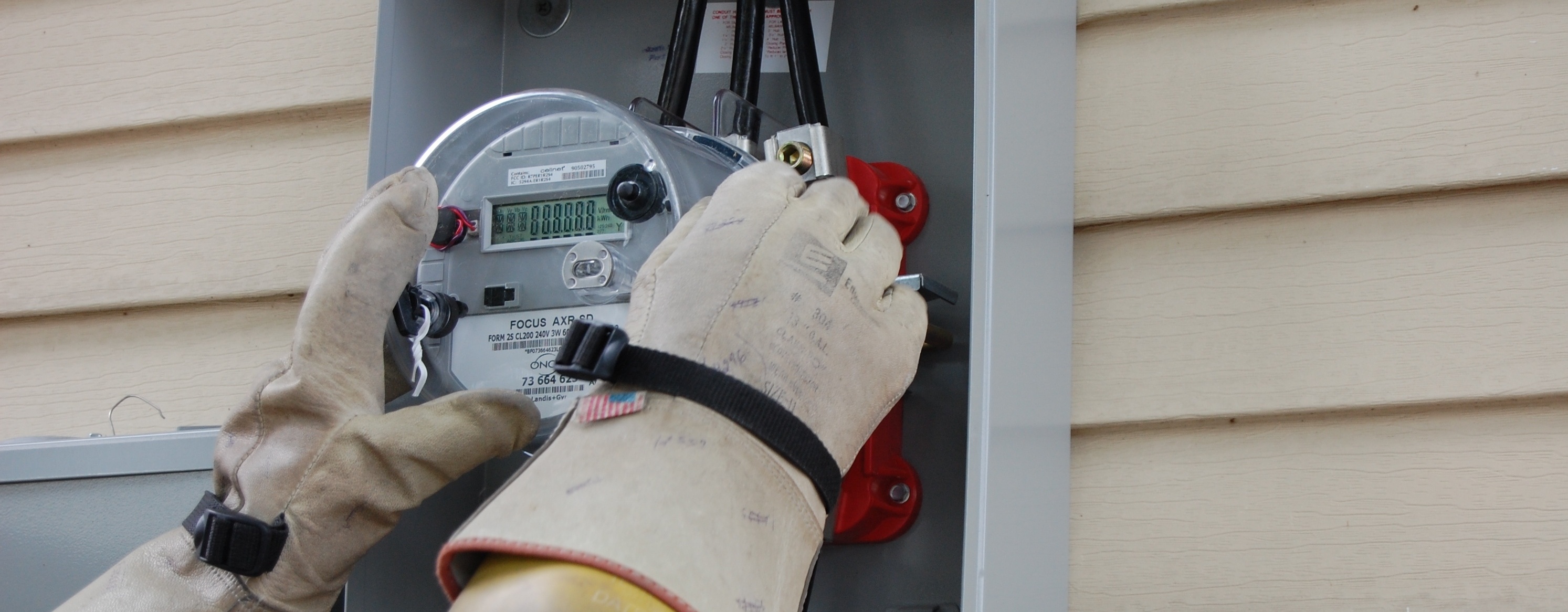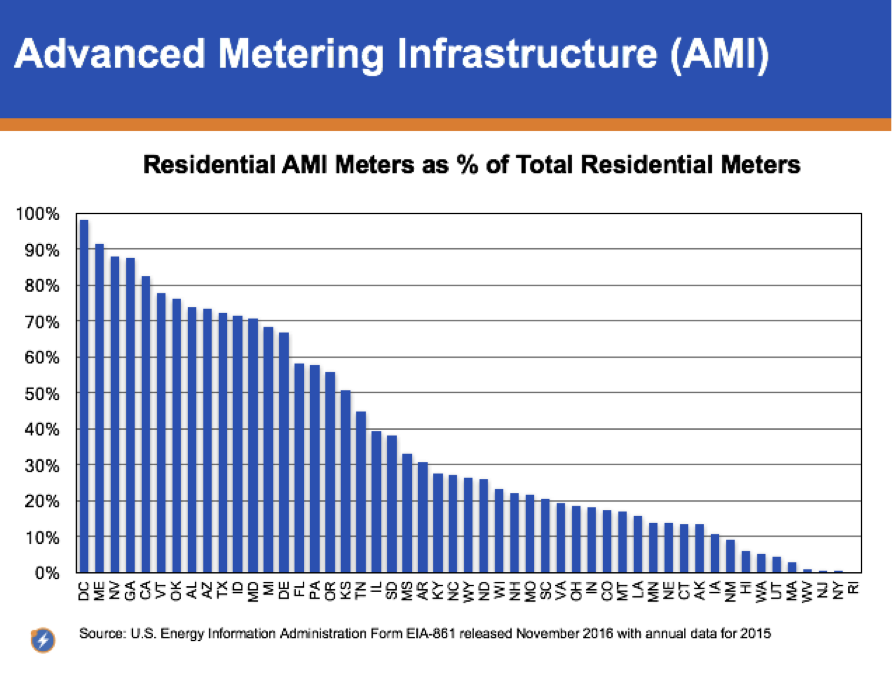
A successful transition to a 21st Century Electricity System requires careful consideration of a range of issues that will ultimately redefine the regulatory framework and utility business model while creating new opportunities for third-party providers and customers to contribute to the operation of the electricity system. In this first of a seven-part series published by Utility Dive, AEE looks at the transformative impact of advanced metering infrastructure. Commonly defined as an integrated network of smart meters, communication networks, and data management systems, AMI has the potential to transform how utilities, customers, and third-party providers manage electricity generation, delivery, and use.
According to the U.S. Energy Information Administration’s most recent data, there are about 58 million residential advanced meters (also called “smart meters”) installed in the United States, representing over 40% of all households, and growing. Leaders in advanced meter deployment include Washington, D.C., Maine, Nevada, Georgia, California, and Vermont.
AEE views the deployment of smart meters as a foundational step toward enabling a smart grid and animating a market in distributed energy resources (DER). AEE also uses the term Advanced Metering Functionality (AMF). Whereas AMI typically refers to a specific technology solution deployed directly by utilities, AMF is a broader term that refers to the capabilities that the technology provides, leaving the door open for a wider range of technologies and solutions to provide the same or similar capabilities. AMF provides a platform for utilities and third-party service providers to offer highly granular data on individual customers’ energy usage, in some cases with near real-time access. These data are essential building blocks for customized load management programs and other services that can empower customers to effectively and simply control their energy usage and costs. AMF can also improve system-wide efficiency by enabling utilities to develop more precise real-time load monitoring and forecasting capabilities.
The individualized, granular, and timely data provided by AMF is indispensable for customer engagement efforts. For example, with AMF, DER providers can analyze customer usage patterns and develop tailored recommendations for DER offerings or rates that will produce the greatest savings for each customer’s circumstances. AMF can also empower customers to take control of their energy bills through timely, individualized insights such as high bill alerts. Of equal importance, AMF allows for the measurement and verification of changes in consumption of individual customers so that they can be accurately accounted for and valued, for example, in peak-time rebate programs.
However, for all the benefits of AMF to be realized, advanced meters must be coupled with other technologies, functionalities, services, and dynamic pricing programs, such as time varying rates (TVR). On that basis, most of the AMI meters installed in the United States are not yet being utilized to their full potential. For example, only 1% of meters in the United States are AMI-connected to a home area network (HAN) gateway, which allows the meter to communicate with devices in a customer's home. Similarly, not all smart meters are connected to a meter data management (MDM) system, which provides information to the customer and uses interval data for billing.
At AEE, we support the deployment of AMF as soon as possible as an enabling platform for other technologies and to allow for the adoption of programs and services that will transform how customers, utilities, and third-party service providers interact with a modern grid. That said, there are a variety of questions that regulators, policymakers, utilities, and other stakeholders must consider before undertaking an AMF deployment:
- Who will own and maintain the infrastructure?
- Which customers should receive AMF?
- What is the most cost-effective deployment strategy?
- Who will pay for deployment?
- How will privacy concerns with regard to customer and third-party access to data be handled? What standards and oversight is required if third parties provide AMF (e.g., billing accuracy, data access, privacy)?
Many states have already or are currently grappling with these questions.
Most recently, on August 29, Hawaiian Electric Co. filed a final $205 million grid modernization plan that includes a targeted smart meter deployment. The Colorado Public Utilities Commission also recently approved a settlement agreement on July 25 that, among other things, initiates a full advanced metering infrastructure roll-out in Xcel Energy’s service territory commencing in 2020. Not to be out done, Entergy has been busy seeking approval for AMI roll-outs across several jurisdictions in 2017, including recent affirmative decisions in Louisiana, Mississippi, Arkansas, and a pending application in Texas.
There is no one-size-fits-all solution for a successful AMF deployment. Nevertheless, past experience suggests that the following basic framework can be used to help policymakers, regulators, and utilities design and implement a program for deployment that best fits their specific needs and circumstances:
- Laying the Foundation: Policymakers should begin a dialogue among utilities, third party providers, customers, and other stakeholders. The stakeholders involved must educate themselves on the concept of advanced metering, consider all possible barriers to adoption and the unique challenges in their service territories, and establish a practical framework to achieve a successful deployment.
- Developing a Plan: Experience globally and in the United States has shown utility ownership to be the most cost-effective in the vast majority of cases. However, third-party providers can help with customer engagement and DER deployment, either on behalf of the utility or on their own, enabled by AMF. As a general rule, the benefits of AMF – both operational and direct customer benefits – are best achieved through universal deployment rather than on a customer-by-customer basis. Full-scale deployment enables both the framework for DER and customer facing solutions that provide immediate benefits of AMF. The cost per meter for installation increases when deployment is targeted at only some of the customers in a designated area, and some of the benefits of AMF cannot be fully realized unless all customers have the technology.
- Enabling the Full Suite of Benefits: While there are immediate operations and maintenance (O&M) and service quality benefits associated with the deployment of AMF itself, most customer benefits are contingent on further actions by utility regulators that enable options such as time-varying rates, integration of plug-in electric vehicles, Volt-VAR optimization, distribution automation, demand response, and behavioral energy efficiency. In order for regulators to make fully informed decisions, they should require that utilities explore AMF deployment through business cases that capitalize on the full functionality available. Furthermore, the benefits of AMF will not be fully realized unless policies are instituted before AMF is deployed, rather than after, so that customers and their designated third parties gain access to data in a timely fashion.
AMF is a foundational element of the modern grid, with the potential to transform how customers, third parties, and utilities manage electricity generation, delivery, and use. Whether AMF lives up to its potential, however, depends on how it gets put to use. Policymakers, regulators, utilities, and customers all have a role to play in getting the most out of advanced meter investments.
Image courtesy of Landis+Gyr
AEE’s issue brief, Advanced Meters: Connectivity for the Modern Grid, as well as six other related issue briefs, are available for download .
